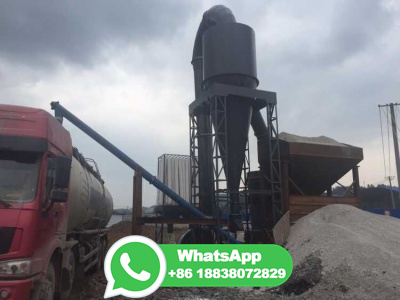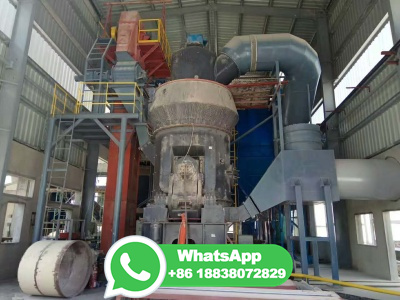
WEBDec 1, 2016 · Block flow diagrams (BFD) of direct CBTL plants are shown in Fig. 1, Fig. technology is the core technology for all different configurations. Coal and biomass with a low biomass/coal ratio (8/92 wt basis, base case) are mixed with the recycled oil in the slurry tank, and then pressurized and preheated before being fed to .
WhatsApp: +86 18203695377
WEBAug 1, 2015 · Thermochemical conversion processes mainly include combustion, pyrolysis, gasifiion, and liquefaction [8], [9], [10], [11].Liquefaction is a lowtemperature (250–400 °C) and highpressure (5–20 MPa) thermochemical process during which the biomass is converted into three products, a biooil fraction (target product), a gas .
WhatsApp: +86 18203695377
WEBThis paper presents a brief state of the art review of direct coal liquefaction. The review includes important pilot scale processes available for the liquefaction an a brief description of the structure of coal and the chemistry, mechanism and available lumped kinetic models for the liquefaction process. It also includes some discussions on ...
WhatsApp: +86 18203695377
WEBThis better knowledge of coal should make a significant longterm contribution to advanced coal conversion technology. Download Free PDF View ... Indirect liquefaction process coal is liquefied through the Fischer– Tropsch (FTS) process. ... Power 148:42–50 Vamvuka D, Zografos D, Alevizos G (2008) Control methods for mitigating biomass ash ...
WhatsApp: +86 18203695377
WEBDCL technology was invented by Friedrich Bergius in 1913. This technology directly produces liquid fuels from coal with the basic process that dissolves coal at high temperature and pressure and adds hydrogen to increase the hydrogen content [11]. DCL is the most efficient technology among the three current technologies.
WhatsApp: +86 18203695377
WEBAug 1, 2022 · The conversion routes of biomass are mainly summarized in Fig. biochemical conversion has been widely used for the production of biogas and ethanol fuel [18, 19], our article focuses on the thermochemical conversion routes in particular pyrolysis, hydrothermal liquefaction and gasifiion as these processes .
WhatsApp: +86 18203695377
WEBSep 1, 2011 · However, there is hardly any technoeconomic study of the DCL technology conducted by using rigorous process and economic models especially while considering CO 2 capture, biomass coprocessing ...
WhatsApp: +86 18203695377
WEBNov 29, 2017 · Coal. Direct coal liquefaction (DCL) and indirect coal liquefaction (ICL) are the two prominent processes for coaltomethanol conversion. DCL primarily involves thermal breaking of the polymeric coal structure at elevated temperatures with subsequent hydrogenation of the fragments to generate lighter molecules.
WhatsApp: +86 18203695377
WEBNov 1, 2011 · Some researchers have reported that coliquefaction of biomass and coal under mild condition (about 350°C) has higher conversion and oil yield than those that would be predicted based on a simple ...
WhatsApp: +86 18203695377
WEBDownloadable! The growing demand for petroleum, accompanied by the declining petroleum reserves and the concerns over energy security, has intensified the interest in direct coal liquefaction (DCL), particularly in countries such as China which is rich in coal resources, but short of petroleum. In addition to a general introduction on the .
WhatsApp: +86 18203695377
WEBSep 12, 2021 · Figure : Next thermochemical conversion method of biomass – direct liquefaction. (The fourth, combustion, is not really a thermochemical conversion of biomass). Credit: Dr. Caroline B. Clifford. There are differences for each of the thermal processes, as described in Lesson 5. Here we focus on direct liquefaction.
WhatsApp: +86 18203695377
WEBSep 21, 2020 · Algae biomass has recently attracted the attention of the green energy industry as a raw material for biofuels production. Their highwater content has led to the choice of hydrothermal liquefaction as a suitable way to convert them into biooil. From algae species to biooil as fuel, many steps are required, including the selection of algae .
WhatsApp: +86 18203695377
WEBJun 3, 2022 · Status of Biomass Combustion Technology. Biomass combustion is applied in many situations, for example, cooking or heating in, producing steam or hot oil for industrial process, and power generation in utility power plant. In general, biomass is a process of solid combustion and a typical gas–solid chemical reaction.
WhatsApp: +86 18203695377
WEBHTL, also called hydrothermal upgrading, hydrothermal processing, and direct liquefaction (Xiu and Shahbazi 2012), is a thermochemical process that allows the conversion of biomass to liquids, generally carried out in the absence of oxygen and in the presence of a solvent, most of the times water. The fact that water is both solvent and ...
WhatsApp: +86 18203695377
WEBDec 1, 2014 · The environmental footprint of coal liquefaction processes can usually be reduced by coprocessing coal and biomass and applying CO 2 capture and storage (CCS) technology but at the cost of higher ...
WhatsApp: +86 18203695377
WEBNov 1, 2023 · The thermochemical conversion of biomass, including liquefaction, torrefaction, pyrolysis, and gasifiion technologies, has attracted worldwide attention because these processes can convert biomass into alternative, sustainable, and ecofriendly fuels, such as biochar, biooil, and H 2 rich gas. However, there are some .
WhatsApp: +86 18203695377
WEBJul 1, 2012 · Direct coal liquefaction process is the core of ... study of the DCL technology conducted by using rigorous process and economic models especially while considering CO 2 capture, biomass co ...
WhatsApp: +86 18203695377
WEBOn the surface, it looks pretty much the same as the process of coal liquefaction. It is a thermochemical conversion process of organic material into liquid biocrude and coproducts. Depending on the process, it is usually conducted under moderate temperatures (300400°C, lower than coal liquefaction) and pressures (1020 MPa, similar or ...
WhatsApp: +86 18203695377
WEBHydrothermal liquefaction (HTL) is a thermal depolymerization process used to convert wet biomass, and other macromolecules, into crudelike oil under moderate temperature and high pressure. The crudelike oil has high energy density with a lower heating value of MJ/kg and 520 wt% oxygen and renewable chemicals. The process has also .
WhatsApp: +86 18203695377
WEBDec 1, 2003 · This paper reports detailed process designs and cost assessments for production of clean liquid fuels (methanol and dimethyl ether) by indirect coal liquefaction (ICL). Gasifiion of coal pro ...
WhatsApp: +86 18203695377
WEBDue to insecurity in the crude oil supply and global warming, various alternative technologies for fuel production are being investigated. In this project, indirect, direct, and hybrid liquefaction routes are investigated for production of transportation fuels from coal and biomass. Indirect coal liquefaction (ICL) and direct coal liquefaction (DCL) .
WhatsApp: +86 18203695377
WEBAug 8, 2023 · In recent years, several researchers have studied various process types for the conversion of biomass. Different processes, such as thermochemical and biochemical, have been used to convert biomass into valuable forms of energy . The conversion technology option is dependent on the amount of property, the type of .
WhatsApp: +86 18203695377
WEBJan 1, 2018 · Biomass can be converted into several useful forms of energy using different processes. Fig. portrays a number of different biomass (to bioenergy) conversion pathways. Various factors affect the choice of conversion process; these can include: the type, quantity, and characteristics of biomass feedstock, the desired form of the energy .
WhatsApp: +86 18203695377
WEBJan 15, 2021 · Hydrothermal liquefaction is one of the most promising technologies to convert high moisture biomass into biofuels. However, understanding the liquefaction mechanism of different biomass fractions is still a challenge. The liquefaction of both lignin and cellulose is frequently studied, but the high diversity of biomass and processes .
WhatsApp: +86 18203695377
WEBDec 1, 2020 · Generally, biomass gasifiion is an endothermic thermochemical conversion of solid biomass fuel using gasifying agents such as air, steam or CO 2 to form a mixture of combustible gases which may include H 2, CH 4, CO and CO 2. The process is carried out at temperatures between 800 and 1300°C.
WhatsApp: +86 18203695377
WEBOct 1, 2021 · The operating cost of the liquefaction process is reported to be similar to fast pyrolysis. However, it requires a higher capital investment due to the difference in biomass conversion and liquefaction pressures. Biomass liquefaction costs range between /gal based on the technology level (Brown, 2019).
WhatsApp: +86 18203695377
WEBMar 1, 2015 · The increasing demand for petroleum and the limited fossil fuel storage has urged great efforts and researches on improving current fuel and energy conversion technologies [1]. The coal liquefaction technology has become an effective way of clean utilization of coal for not only the preparation of high calorific value fuels [2], but also a ...
WhatsApp: +86 18203695377
WEBApr 27, 2020 · A comprehensive model of thermal conversion as a function of temperature, pressure and heating rate of biomass has been provided. For the most important, basic process, which is pyrolysis, five mechanisms of thermal decomposition kinetics of its components (lignin, cellulose, hemicellulose) were presented.
WhatsApp: +86 18203695377
WEBDec 1, 2016 · Coal Conversion Processes. December 2016. DOI: / In book: KirkOthmer Encyclopedia of Chemical Technology. Authors: James G. Speight. To read the full ...
WhatsApp: +86 18203695377
WEBMar 18, 2013 · The conversion of these DCL residues to lighter, highvalue products is an important step in helping to make this technology both commercially viable and environmentally acceptable. This paper provides an overview of the physicochemical characteristics and processing options available for coal liquefaction residues and .
WhatsApp: +86 18203695377
WEBMay 1, 1999 · An overview of conversion of residues from coal liquefaction processes. S. Khare M. Dell'amico. Environmental Science, Chemistry. 2013. Direct coal liquefaction (DCL) is a process for converting coal to synthetic oils, which can be refined to make transportation fuels. Residue from this process contains inorganic material such as..
WhatsApp: +86 18203695377
WEBAdvances in Clean Hydrocarbon Fuel Processing || Direct liquefaction (DCL) processes and technology for coal and biomass conversion. Elsevier, pages 105154, 2011 ... (DCL) processes and technology for coal and biomass conversion Author. Burgess Clifford, C. Publisher. Elsevier Edition/series info. pages 105154, 2011 Year. 2011 .
WhatsApp: +86 18203695377
WEBDirect liquefaction (DCL) processes and technology for coal and biomass conversion. 2011, 105154. ... A new process for alytic liquefaction of coal using dispersed MoS2 alyst generated in situ with added H2O. Fuel 2000, 79 ... Mechanochemical effects in coal conversion. 1. Coal hydrogenation in gaseous hydrogen aided by mechanical .
WhatsApp: +86 18203695377
WEBJan 1, 2023 · Direct coal liquefaction (DCL) commonly refers to alytic hydrogenation of coal in a recycled oil solvent at high pressures with a alyst. While a range of process configurations have been proposed, the most common version involves at least two high pressure slurry reactors in a series using a dispersed ironbased alyst and hydrogen ...
WhatsApp: +86 18203695377